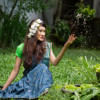Nature Quest: Golden flower Kuchai

I have heard of Patharia hills in Moulvibazar's Borolekha from the numerous writings of Prof Dwijen Sharma. He had spent his childhood playing around the hills. However, I was rather amazed by recent information that the Patharia hills is home to our lone wild variety of Magnolia Dulichapa (Magnolia pterocarpa).
I had been to Moulvibazar quite a few times but could not manage to go to the Patharia hills. Therefore, the recent trip was entirely planned to that end. We stayed in Borolekha upazila headquarters, which is quite close to the Patharia hills. We got to the foothill early in the morning and were lost in the silence of the hills. While walking past a fountain, my eyes caught sight of something in the foothill in the shape of a dazzling yellow flower bouquet. Braving a number of thorny bushes, we finally got there and saw the beautiful fragrant flowers. I took photographs of them and collected samples.
A few days later, I spotted the flowers in the natural hillocks around Samanbagh Tea Estate and in the hills of Khagrachhari. Nature in our hills and forests adorn herself with this sort of flowers. After coming back to Dhaka, I sent the samples to the Bangladesh National Herbarium. A senior scientific officer there identified that the scientific name of the tree is Caesalpinia enneaphyllum. Locals know the tree as Kuchai. The name "Kanaklata" can also be considered. There is of course a creeper named Kanaksudha.
In the Caesalpinia family, there are two intimate species -- Radhachura and Kanakchura. One of them comes from the temperate zones of South America. Though they are similar in terms of the formation of leaves, the trees are altogether different. The tubular golden yellow flowers hang downwards like bells. One part of the petal is upside down, the tip of stamen is blackish. The flowers bloom serially from top to bottom. The prime blooming season is Kartik-Agrahayan. Caesalpinia is basically a shrub or tree from the temperate or subtropics areas. There are 2,000 varieties of them, including the trees, shrubs and creepers.

 For all latest news, follow The Daily Star's Google News channel.
For all latest news, follow The Daily Star's Google News channel. 








Comments